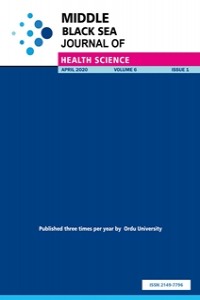Influence of reciprocating NiTi instruments on the accuracy of apex locator integrated endomotors during simultaneous working length determination
Abstract
Objective: To compare simultaneous working length determination efficiency and electrical resistance of thermally treated NiTi files and their counterfeits.
Methods: Access cavities were prepared for sixty human mandibular premolar teeth, which were then numbered with a marker. Actual working length was determined visually by introducing a #10 K-file into the root canal and the reference point was marked for further steps. By using flowable composite, the teeth were fixed at the cementoenamel junction to a hole in the center of a glass bottle cap and a second hole prepared on it for lip clip. Alginate impression material was filled into glass bottle then the tooth was embedded into it. Experimental models randomly divided into 6 groups as Group WOG (WaveOne Gold), Group WO (WaveOne), Group W+ (Superline W+), Group RB (Reciproc Blue), Group R (Reciproc), Group V (Superline V). Root canals were prepared until the endomotor stopped when reaching the apical foramen and the silicon stopper was moved to the previously marked reference point to determine the simultaneous working length. The electrical resistance of the files (from tip of file to notch of the shaft) was measured using a multimeter.
Results: No readings could be obtained via apex locator for Group V. Group W+ was significantly less accurate compered the other groups (p<0.05). No significant difference was found among the groups WO, WOG, R, and RB (p>0.05).
Conclusion: Thermal treatments of NiTi alloys had no effect on the accuracy of simultaneous working length determination. However, Counterfeit endodontic files failed to show of accurate simultaneous working length determination.
Project Number
yok
References
- Arslan H, Güven Y, Karataş E, Doğanay E. Effect of the Simultaneous Working Length Control during Root Canal Preparation on Postoperative Pain. J Endod 2017; 43(9): 1422–7. doi:10.1016/j.joen.2017.04.028
- Gavini G, Santos MD, Caldeira CL, et al. Nickel-titanium instruments in endodontics: a concise review of the state of the art. Braz Oral Res. 2018; 32(suppl 1): e67. doi:10.1590/1807-3107bor-2018.vol32.0067
- Hancocks S. Beware and be aware. Br Dent J 2016; 220(2): 43. doi:10.1038/sj.bdj.2016.36
- Nekoofar MH, Ghandi MM, Hayes SJ, Dummer PMH. The fundamental operating principles of electronic root canal length measurement devices. Int Endod J 2006; 39: 595–609. doi:10.1111/j.1365-2591.2006.01131.x
- Orafi I, Rushton VE. The use of radiography and the apex locator in endodontic treatment within the UK: a comparison between endodontic specialists and general dental practitioners. Int Endod J 2013; 46: 355–64. doi:10.1111/j.1365-2591.2012.02127.x
- Proffitt E. Counterfeit and Non-Compliant Dental Devices: The Dangers and How to Mitigate Them. Dent Update 2016; 43(4): 307–12. doi:10.12968/denu.2016.43.4.307
- Ricucci D, Russo J, Rutberg M, Burleson JA, Spångberg LS. A prospective cohort study of endodontic treatments of 1,369 root canals: results after 5 years. Oral Surg Oral Med Oral Pathol Oral Radiol Endod 2011; 112(6): 825–842. doi:10.1016/j.tripleo.2011.08.003
- Rodrigues CS, Vieira VTL, Antunes HS, De-Deus G, Elias CN, Moreira EJL, Silva EJNL. Mechanical characteristics of counterfeit Reciproc instruments: a call for attention. Int Endod J 2018; 51: 556–63. doi:10.1111/iej.12792
- Shen Y, Zhou HM, Zheng YF, Peng B, Haapasalo M. Current challenges and concepts of the thermomechanical treatment of nickel-titanium instruments. J Endod 2013; 39(2): 163–172. doi:10.1016/j.joen.2012.11.005
- Sipavičiūtė E, Manelienė R. Pain and flare-up after endodontic treatment procedures. Stomatologija. 2014; 16(1): 25–30.
- Thompson SA. An overview of nickel-titanium alloys used in dentistry. Int Endod J 2000; 33: 297–310. doi:10.1046/j.1365-2591.2000.00339.x
- Zupanc J, Vahdat-Pajouh N, Schäfer E. New thermomechanically treated NiTi alloys - a review. Int Endod J 2018; 51(10): 1088–103. doi:10.1111/iej.12924
Abstract
Supporting Institution
yok
Project Number
yok
Thanks
Yok
References
- Arslan H, Güven Y, Karataş E, Doğanay E. Effect of the Simultaneous Working Length Control during Root Canal Preparation on Postoperative Pain. J Endod 2017; 43(9): 1422–7. doi:10.1016/j.joen.2017.04.028
- Gavini G, Santos MD, Caldeira CL, et al. Nickel-titanium instruments in endodontics: a concise review of the state of the art. Braz Oral Res. 2018; 32(suppl 1): e67. doi:10.1590/1807-3107bor-2018.vol32.0067
- Hancocks S. Beware and be aware. Br Dent J 2016; 220(2): 43. doi:10.1038/sj.bdj.2016.36
- Nekoofar MH, Ghandi MM, Hayes SJ, Dummer PMH. The fundamental operating principles of electronic root canal length measurement devices. Int Endod J 2006; 39: 595–609. doi:10.1111/j.1365-2591.2006.01131.x
- Orafi I, Rushton VE. The use of radiography and the apex locator in endodontic treatment within the UK: a comparison between endodontic specialists and general dental practitioners. Int Endod J 2013; 46: 355–64. doi:10.1111/j.1365-2591.2012.02127.x
- Proffitt E. Counterfeit and Non-Compliant Dental Devices: The Dangers and How to Mitigate Them. Dent Update 2016; 43(4): 307–12. doi:10.12968/denu.2016.43.4.307
- Ricucci D, Russo J, Rutberg M, Burleson JA, Spångberg LS. A prospective cohort study of endodontic treatments of 1,369 root canals: results after 5 years. Oral Surg Oral Med Oral Pathol Oral Radiol Endod 2011; 112(6): 825–842. doi:10.1016/j.tripleo.2011.08.003
- Rodrigues CS, Vieira VTL, Antunes HS, De-Deus G, Elias CN, Moreira EJL, Silva EJNL. Mechanical characteristics of counterfeit Reciproc instruments: a call for attention. Int Endod J 2018; 51: 556–63. doi:10.1111/iej.12792
- Shen Y, Zhou HM, Zheng YF, Peng B, Haapasalo M. Current challenges and concepts of the thermomechanical treatment of nickel-titanium instruments. J Endod 2013; 39(2): 163–172. doi:10.1016/j.joen.2012.11.005
- Sipavičiūtė E, Manelienė R. Pain and flare-up after endodontic treatment procedures. Stomatologija. 2014; 16(1): 25–30.
- Thompson SA. An overview of nickel-titanium alloys used in dentistry. Int Endod J 2000; 33: 297–310. doi:10.1046/j.1365-2591.2000.00339.x
- Zupanc J, Vahdat-Pajouh N, Schäfer E. New thermomechanically treated NiTi alloys - a review. Int Endod J 2018; 51(10): 1088–103. doi:10.1111/iej.12924
Details
| Primary Language | English |
|---|---|
| Subjects | Health Care Administration |
| Journal Section | Research articles |
| Authors | |
| Project Number | yok |
| Publication Date | April 30, 2020 |
| Published in Issue | Year 2020 Volume: 6 Issue: 1 |


